Tesla Model 3: Airbags
Airbags inflate when sensors detect an impact
that exceeds deployment thresholds. These
thresholds are designed to predict the severity
of a crash in time for the airbags to help
protect the vehicle's occupants. Airbags
inflate instantly with considerable force
accompanied by a loud noise. The inflated
bag, together with the seat belts, limits
movement of occupants to reduce the risk of
injury.
Front airbags are not ordinarily designed to
inflate in rear collisions, rollovers, side
collisions and when braking heavily or driving
over bumps and potholes. Likewise, front
airbags may not inflate in all frontal collisions,
such as minor front collisions, underride
collisions, or minor impacts with narrow
objects (such as posts or poles). Significant
superficial damage can occur to the vehicle
without the airbags inflating and, conversely, a
relatively small amount of structural damage
can cause airbags to inflate. Therefore, the
external appearance of the vehicle after a
collision does not represent whether or not
the front airbags should have inflated. Warning: Before modifying your vehicle
to accommodate a person with
disabilities in a way that may affect the
airbag system, contact Tesla. Types of Airbags Model 3 has the following types of airbags: Passenger Front Airbag Status The status of the passenger front airbag displays in the top corner of the
touchscreen: Model 3 has an occupancy sensor in the front passenger seat that controls the
status of the front
airbag. Note: The occupancy classification system (OCS) meets the
regulatory requirement of FMVSS 208
and automatically detects when inflating the passenger front airbag would be
unnecessary or
potentially harmful. Warning: Seating an infant in a rear facing child safety seat on a
seat equipped with an
operational airbag can cause serious injury or death.
Note: It takes approximately six seconds after you power on Model 3
for the occupant
classification system (OCS) to report accurate status of the front passenger
airbag. As a result,
when you first power on Model 3, even in situations when it should be OFF
because the seat is occupied by a weight of 20 lbs (9 kg) or less, it will take
the touchscreen approximately six
seconds to display the status, PASS AIRBAG OFF. If it fails to do so, contact
Tesla Service and do
not seat a child in the front passenger seating position. To make sure the sensing system can correctly detect occupancy status,
eliminate the following: These conditions can interfere with the occupancy sensor. If you have
eliminated the above
possibilities, and the airbag status is still incorrect, ask passengers to ride
in the rear seats and
contact Tesla to have the airbag system checked. Note: The front passenger occupancy sensor affects the operation of
the passenger front airbags
only. The side airbags are not affected. Warning: If the front passenger airbag is not turning on or off as
expected based on the
weight thresholds previously described, contact Tesla immediately. Warning: If seating a child in the front passenger seat is legally
permissible in your market
region, it is the driver's responsibility to ensure that the passenger front
airbag is OFF. Never
seat a child in a rear facing safety seat in the front passenger seat with an
active airbag.
DEATH or SERIOUS INJURY to the child can occur. Per recommendations by the
National
Highway Traffic Safety Administration, all occupants age 12 and under must ride
in the rear
seats. Warning: Do not use seat covers on Model 3. Doing so could restrict
deployment of the seatmounted
side air bags if a collision occurs. It can also reduce the accuracy of the
occupant
detection system, if equipped. To help ensure an occupant in the front
passenger seat can be accurately classified,
the passenger must: In addition to the items listed above, the
following situations can interfere with the
accuracy of the occupant classification
system: These conditions can interfere with the
occupancy sensor. If you have eliminated the
above possibilities, and the airbag status is still
incorrect, instruct passengers to ride in the
rear seats and contact Tesla to have the airbag
system checked.
Note: Tesla follows NHTSA (National Highway
Traffic Safety Administration) recommendations that all occupants age 12
and under must ride in a rear seating position. Note: The front passenger occupancy sensor
affects the operation of the passenger front
airbags only. The side airbags are not affected. Warning: Failure to follow the above
instructions can adversely affect the
Occupant Classification System (OCS)
which can cause serious injury or death. Warning: If the front passenger airbag is
not turning on or off as expected, do not
seat a passenger in the front passenger
seat. Contact Tesla Service. Warning: To ensure accuracy of the
occupant detection system, do not make
any modifications to the front passenger
seat. Warning: Do not use seat covers on Model
3. Doing so could restrict deployment of
the seat-mounted side air bags if a
collision occurs. It can also reduce the
accuracy of the occupant classification
system. Examples of Correct and Incorrect Seating Positions Correct seating position:
Incorrect seating position - the passenger's
feet must be on the floor:
Incorrect seating position - the passenger
must not slide forward on the seat cushion:
Incorrect seating position - the passenger
must not recline the backrest to a laying down
position when the vehicle is moving:
Warning: When airbags inflate, a fine
powder is released. This powder can
irritate the skin and should be thoroughly
flushed from the eyes and from any cuts
or abrasions. After inflation, the airbags deflate to provide a
gradual cushioning effect for the occupants
and to ensure the driver's forward vision is not
obscured.
If airbags have inflated, or if your vehicle has
been in a collision, your vehicle requires
servicing before it will power up. In addition,
your airbags, seat belt pre-tensioners and any
associated components must be checked, and
if necessary, replaced. Contact Tesla Service
immediately.
In a collision, in addition to the airbags
inflating: Note: In some collisions, even if airbags did
not inflate, high voltage may be disabled and
you will be unable to power up and drive.
Contact Tesla Service immediately. Airbag Warning Indicator Airbag Warnings Warning: All occupants, including the
driver, should always wear their seat belts,
whether or not an airbag is also provided
at their seating position, to minimize the
risk of severe injury or death in the event
of a collision. Warning: Front seat occupants should not
place their arms over the airbag module,
as an inflating airbag can cause fractures
or other injuries. Warning: Do not use seat covers on Model
3. Doing so could restrict deployment of the seat-mounted side air bags if a
collision occurs. It can also reduce the
accuracy of the occupant detection
system, if equipped. Warning: Airbags inflate with
considerable speed and force, which can
cause injury. To limit injuries, ensure that
occupants are wearing seat belts and are
correctly seated, with the seat positioned
as far back as possible. The National
Highway Traffic Safety Administration
(NHTSA) recommends a minimum
distance of 10" (25 cm) between an
occupant's chest and an airbag. Warning: Children should not be seated
on the front passenger seat unless
permitted by regulations in your market
region. Follow all regulations in your
region for the appropriate way to seat a
child based on the child's weight, size,
and age. The safest place to seat infants
and young children is in a rear seating
position. Seating an infant or child in a
rear-facing child restraint system on a
seat equipped with an operational airbag
can cause serious injury or death. Warning: Do not use a rear-facing child
safety seat on a seat with an operational
airbag in front of it. Doing so can cause
injury or death if the airbag inflates. Warning: To ensure correct inflation of the
side airbags, maintain an unobstructed
gap between an occupant's torso and the
side of Model 3. Warning: Passengers shouldn't lean their
heads against doors. Doing so can cause
injury if a curtain airbag inflates. Warning: Do not allow passengers to
obstruct the operation of an airbag by
placing feet, knees or any other part of
the body on or near an airbag. Warning: Do not attach or place objects
on or near the front airbags, the side of
the front seats, the headliner at the side
of the vehicle, or any other airbag cover
that could interfere with inflation of an
airbag. Objects can cause serious injury if
the vehicle is in a collision severe enough
to cause the airbag to inflate. Warning: Following inflation, some airbag
components are hot. Do not touch until
they have cooled.How Airbags Work
 Before driving with a child seat
Before driving with a child seat
on the front passenger seat (if legally
permitted in your market region), always double-check the status of the
passenger front airbag to confirm that it is OFF. When the passenger
front airbag is OFF, it will not inflate when a collision occurs. This
indicator also displays when the seat is unoccupied. To protect an adult occupying
To protect an adult occupying
the front passenger seat, ensure the
passenger front airbag is ON. When the passenger front airbag is ON, it
may inflate when a collision occurs.Controlling the Passenger Front Airbag
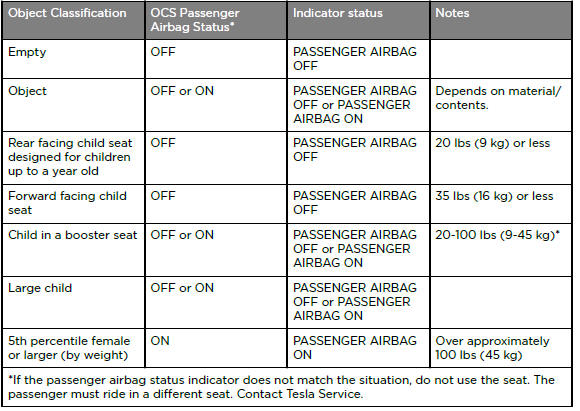
Ensuring Accurate Occupant
Classification
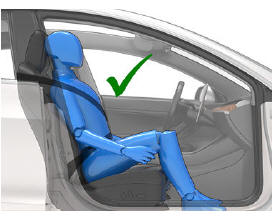
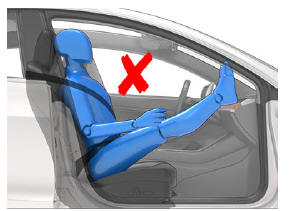
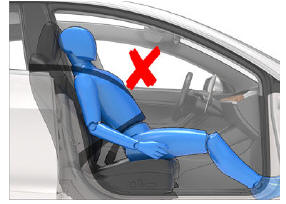
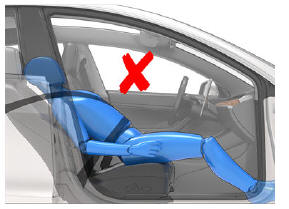
Inflation Effects
 The airbag indicator on the
The airbag indicator on the
touchscreen remains lit if the airbag
system is malfunctioning. The only
time this indicator should light up is
briefly when Model 3 first powers up,
in which case it turns off within a few
seconds. If it remains lit, contact
Tesla immediately and do not drive.

